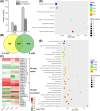Rice transcription factors OsNIGT2/3 regulate nitrogen acquisition by repressing OsNRTs and OsAMTs under high-nitrogen conditions
- PMID: 40672557
- PMCID: PMC12263960
- DOI: 10.3389/fpls.2025.1591808
Rice transcription factors OsNIGT2/3 regulate nitrogen acquisition by repressing OsNRTs and OsAMTs under high-nitrogen conditions
Abstract
Introduction: Nitrogen is a crucial nutrient for crop growth, yet its utilization efficiency is generally low, leading to resource waste and serious environmental problems. Future agricultural sustainability requires improved crop NUE. In this study, we investigated the functions of the rice transcription factors OsNIGT2 and OsNIGT3 in nitrate uptake under high-nitrogen conditions.
Methods: Hydroponic experiments and field tests were conducted to investigate the effects of OsNIGT2 and OsNIGT3 on physiological phenotypes and nitrogen use efficiency. Transcriptome analysis was used to explore the genome-wide transcriptional landscape of the two genes in response to nitrate availability. DNA affinity purification sequencing (DAP-seq) was employed to identify genomic sites bound by OsNIGT2, subsequently, yeast one-hybrid and transient expression assays verified the regulatory effects of OsNIGT2 and OsNIGT3 on key genes.
Results: The double mutants of OsNIGT2 and OsNIGT3 presented significantly greater dry weights, nitrogen contents, total amino acid contents, and nitrate levels than the WT, whereas the single mutants presented no significant differences. These findings indicate the functional redundancy of OsNIGT2 and OsNIGT3 in regulating nitrogen uptake and assimilation. OsNIGT2 and OsNIGT3 act as transcriptional repressors, negatively regulating the expression of nitrogen absorption-related genes. Furthermore, DAP-seq identified potential targets bound by OsNIGT2, highlighting its role in the expression of several nitrogen and phosphorus utilization-related genes. Additionally, field tests shown that OsNIGT2 and OsNIGT3 knockout promotes both grain yield and NUE. This study provides potential genetic targets for improving yield and NUE in rice and other crops, laying a significant foundation for future crop improvement.
Keywords: NUE; OsAMTs; OsNIGT2; OsNIGT3; OsNRTs; rice.
Copyright © 2025 Du, Cong, Ruan, Yang, Shi, Luo and Luo.
Conflict of interest statement
The authors declare that the research was conducted in the absence of any commercial or financial relationships that could be construed as a potential conflict of interest.
Figures








Similar articles
-
[BnaNRT1.5s mediates nitrate transporter to regulate nitrogen use efficiency in Brassica napus].Sheng Wu Gong Cheng Xue Bao. 2025 Jul 25;41(7):2954-2965. doi: 10.13345/j.cjb.241009. Sheng Wu Gong Cheng Xue Bao. 2025. PMID: 40769571 Chinese.
-
Fecal microbiota-based investigations of nitrogen utilization efficiency and related traits in a Landrace × Piétrain crossbred population.J Anim Sci. 2025 Jan 4;103:skaf028. doi: 10.1093/jas/skaf028. J Anim Sci. 2025. PMID: 39909847
-
OsRF2b interacting with OsbZIP61 modulates nitrogen use efficiency and grain yield via heterodimers in rice.Plant Biotechnol J. 2025 Aug;23(8):3300-3312. doi: 10.1111/pbi.70136. Epub 2025 May 26. Plant Biotechnol J. 2025. PMID: 40415532 Free PMC article.
-
Selegiline for Alzheimer's disease.Cochrane Database Syst Rev. 2003;(1):CD000442. doi: 10.1002/14651858.CD000442. Cochrane Database Syst Rev. 2003. PMID: 12535396
-
Sertindole for schizophrenia.Cochrane Database Syst Rev. 2005 Jul 20;2005(3):CD001715. doi: 10.1002/14651858.CD001715.pub2. Cochrane Database Syst Rev. 2005. PMID: 16034864 Free PMC article.
References
LinkOut - more resources
Full Text Sources

